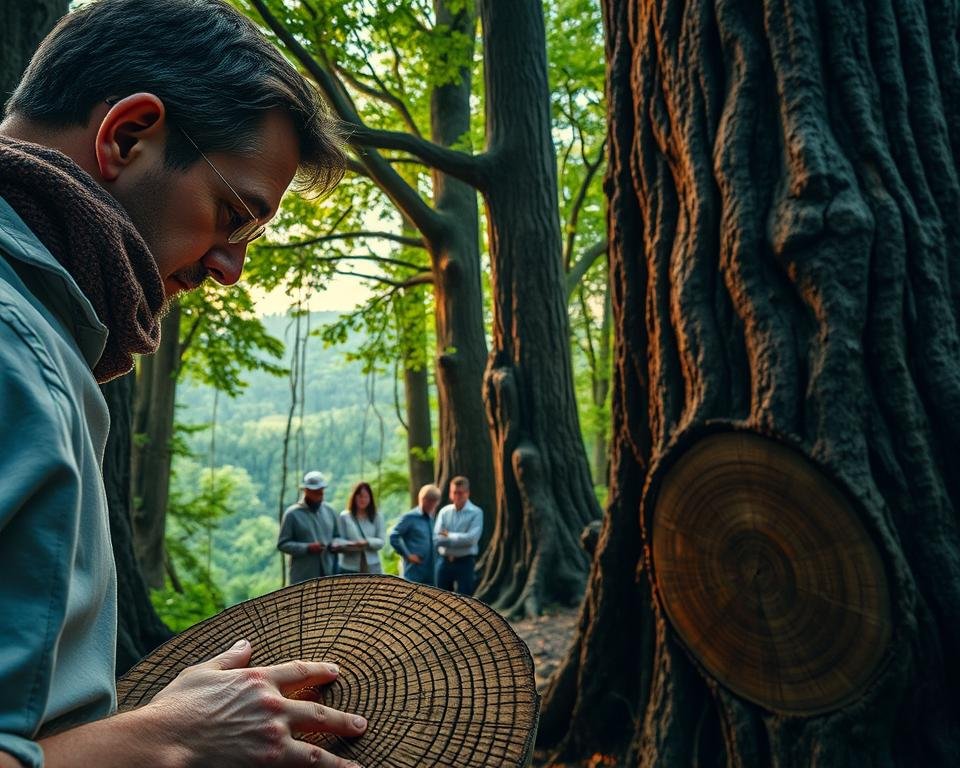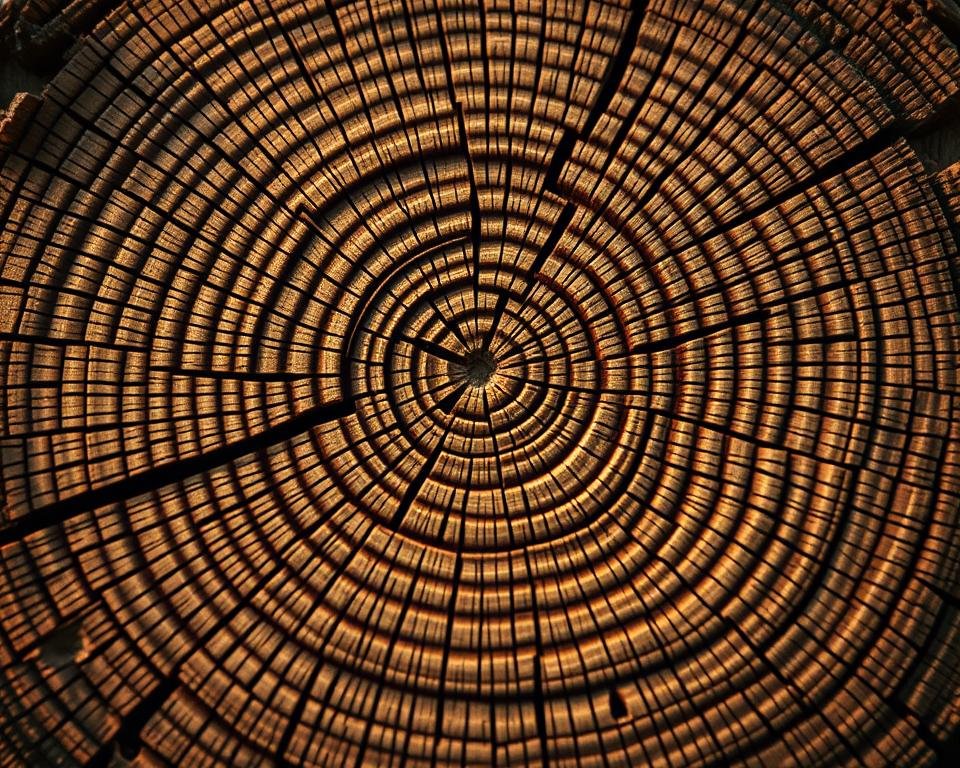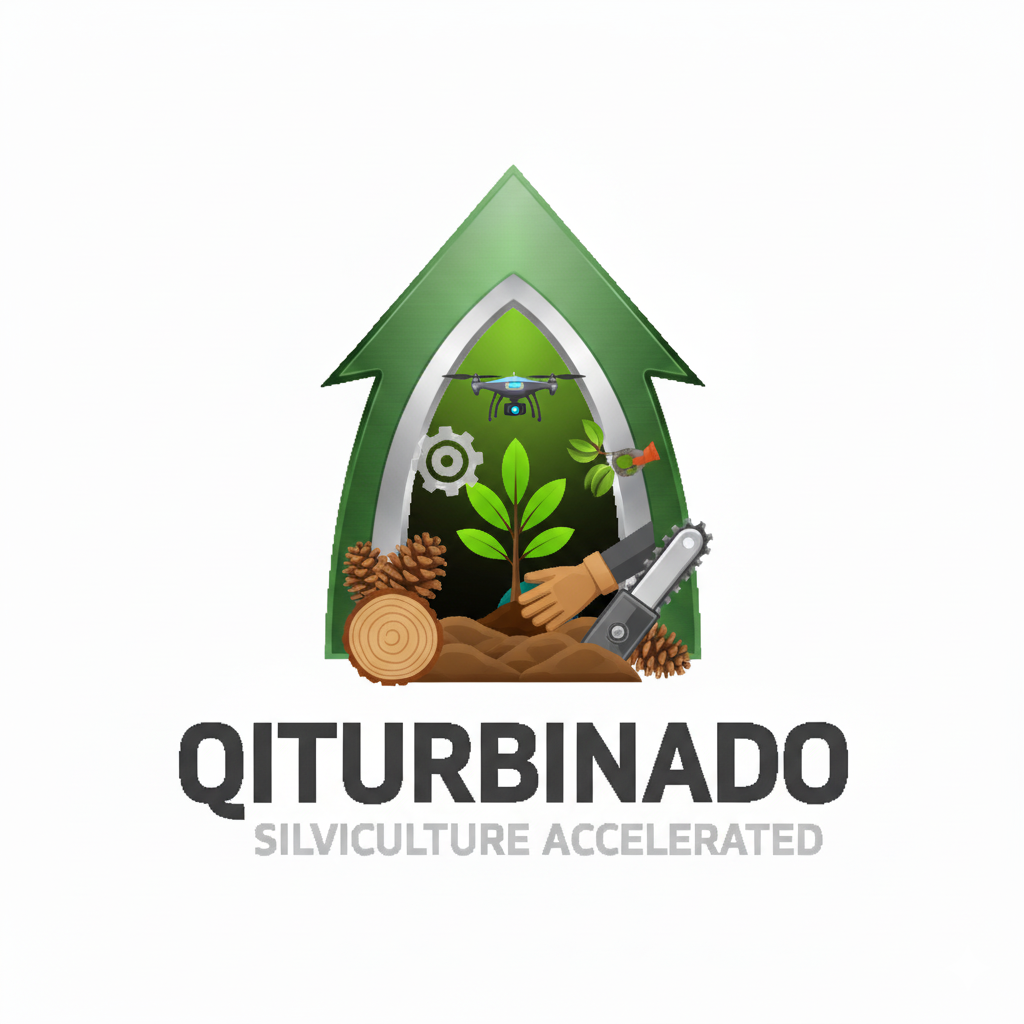Anúncios
Trees hold secrets to the past. Scientists have found that the rings of ancient trees can show centuries-old climate patterns and historical events.
Anúncios
By studying these rings, researchers learn about environmental changes. This includes droughts, volcanic eruptions, and temperature shifts. This field, called Dendrochronology, is key to understanding our world’s history.
Key Takeaways
- Tree rings can reveal historical climate patterns and events.
- Dendrochronology helps scientists understand environmental changes.
- The study of tree rings provides insights into centuries-old natural phenomena.
- Researchers use tree ring data to reconstruct historical events.
- This field of study has significant implications for understanding our world’s past.
What is Dendrochronology?
Dendrochronology is the study of tree rings. It’s a field that reveals the past. Tree rings hold secrets about the environment and the age of trees.
Definition and Overview
Dendrochronology is about studying tree rings. These rings show a tree’s yearly growth. Each ring is a year of growth.
Anúncios
Tree rings change based on climate, soil, and sunlight. By studying these rings, scientists learn about past climates and environments.
Historical Significance
Dendrochronology is key in archaeology and climate science. It helps date wooden artifacts and structures. This gives insights into historical events.
It’s not just for scientists. Dendrochronology helps us understand cultures and history. Dating ancient wooden structures helps historians piece together the past.
Key Terminology
To get dendrochronology, you need to know some terms. Dendroclimatology is studying climate through tree rings. Core sampling is a way to take samples without harming the tree.
- Tree ring: A yearly layer of wood, seen as a ring in a tree trunk.
- Dendrochronologist: A scientist who studies tree rings to understand the environment and date events.
- Growth pattern: The way a tree grows, shown in the rings’ width and characteristics.
How Dendrochronology Works
Dendrochronology, or the study of tree rings, lets us peek into the past. It helps us understand historical environmental conditions. By looking at tree rings, researchers learn about environmental factors that affected tree growth.
Tree rings show a tree’s growth over one year. Their width, density, and other traits tell us about climate, soil, and pollution. This way, dendrochronologists can study a tree’s history and learn about past environments.
Tree Rings Explained
Tree rings are wood layers a tree grows in a year. Each ring’s look changes with the year’s conditions. For example, a tree grows a wider ring in a wet, warm year than in a dry, harsh one.
The rings have two parts: light earlywood and dark latewood. Earlywood forms in spring and early summer, while latewood forms later. This shows how the tree grows at different times.
Analyzing Growth Patterns
Researchers study tree rings to understand growth patterns. They look at ring width, density, and more. This helps spot trends in past environmental conditions. Narrow rings might mean drought, while wide rings suggest good climate.
Special software and stats help analyze these patterns. These tools make big datasets easier to understand and visualize.
| Characteristics | Description | Environmental Indicator |
|---|---|---|
| Ring Width | Measures the width of the tree ring | Climate conditions, growth rate |
| Ring Density | Measures the density of the tree ring | Climate conditions, soil quality |
| Earlywood/Latewood Ratio | Compares the width of earlywood to latewood | Growing season conditions, temperature |
As dendrochronologist Frits Briffa said, “Tree ring study is key to understanding the past and future.” By studying tree growth, we learn about trees and their environment.
“The tree ring record is a unique archive of past climate variability, providing a detailed and annually resolved record of climate change over the past several thousand years.”
Applications of Dendrochronology
Dendrochronology is important in many fields. It helps us understand our environment and history by studying tree rings.
This method is used in many ways. It helps us learn about past climates and how to manage forests. It’s key to understanding our world.
Climate Studies
Dendrochronology is great for studying climate reconstruction. Tree rings show us what the climate was like long ago. This lets scientists know about past temperatures and rain.
This info is vital for understanding climate changes over time. It helps check if climate models are right. By studying tree rings, we can predict future climate changes.
Archaeological Research
In archaeological research, dendrochronology is a big help. It lets us date old events and objects. By matching tree ring patterns, we can find out when things were made.
This method is key for knowing when old buildings and items were built. It helps us understand history better.
Forest Management
Dendrochronology is also important for forest management. It helps us understand how forests change over time. This includes how they react to stress and damage.
This knowledge helps us manage forests better. It ensures forests stay healthy and productive for a long time.
In summary, dendrochronology is useful in many areas. It helps us study climates, understand history, and manage forests. As research grows, so will its uses, helping us learn more about our world.
The History of Dendrochronology
Dendrochronology’s roots go back a long way. Early discoveries set the stage for a field that would reveal the past’s secrets. This journey through history is filled with groundbreaking work and discoveries.
Early Discoveries
In the early 20th century, Andrew Douglass, an American astronomer, saw tree rings’ power. He started dendrochronology, a field now key for understanding history. Douglass believed,
“The tree rings are a natural calendar, recording the events of the past.”
Tree rings weren’t just for climate studies. They also told us about past droughts and eruptions. This made dendrochronology a field that brings together ecology, archaeology, and geology.
Key Figures in the Field
Harold Fritts was a key figure in dendrochronology. He showed how tree rings could help us understand past climates. His work gave us new insights into climate changes.
Other researchers have also made big strides. They’ve shown the value of dendrochronology in understanding history. Their work reminds us of the importance of preserving trees. As Leonard Da Vinci once said,
“The noblest pleasure is the joy of understanding.”
Tools and Techniques in Dendrochronology
Dendrochronology uses advanced tools and techniques to study tree rings. These methods help researchers uncover past information. They analyze data to learn about history.
Core Sampling Methods
Core sampling is key in dendrochronology. It lets researchers take a sample from a tree without harming it. They use an increment borer to get a core sample from the trunk.
This sample has tree-ring data. It shows the tree’s age and growth patterns.
Core sampling involves:
- Choosing the right spot for sampling
- Using quality increment borers to avoid tree damage
- Storing core samples carefully to prevent damage or contamination
Radiocarbon Dating Integration
Radiocarbon dating is also vital in dendrochronology. It measures carbon-14 to find a sample’s age. By combining it with tree-ring analysis, researchers check their work and go further back in time.
Integrating radiocarbon dating means:
- Picking the right samples for carbon-14 analysis
- Matching radiocarbon dates with tree-ring data
- Creating a detailed picture of the past with both methods
Software Utilization
Special software is essential in dendrochronology today. It helps researchers work with big datasets. Programs like COFECHA and ARSTAN help with cross-dating and standardizing tree-ring data.
Using this software has benefits:
- It makes tree-ring dating and analysis more accurate
- It’s great for handling big datasets
- It helps researchers work together using the same methods
By using these tools and techniques, dendrochronologists can study the past more precisely. They gain a deeper understanding of history.
The Role of Dendrochronology in Climate Change Research
Dendrochronology, or the study of tree rings, is key in climate change research. It helps us understand past climates by looking at tree growth patterns. This way, we can see how climates have changed over time.
Historical Climate Data
Tree rings act as a natural climate record, with each ring showing a year’s growth. The ring’s width, density, and isotopic makeup tell us about past temperatures and rainfall. For example, a study on the Wilderness Society website shows how tree rings help us understand climate change’s effects on forests.
To analyze tree rings, scientists use core sampling and radiocarbon dating. These methods help date the rings and link them to known climate events.

Tree ring data is essential for creating historical climate records. For instance, some tree species in the southwestern U.S. have shown drought patterns for thousands of years.
Predictive Modeling
Tree ring data helps create models that predict future climate changes. By studying past climate patterns, scientists can make these models more accurate.
Creating these models involves complex algorithms and statistical analysis. Below is a table showing important factors in these models:
| Factor | Description | Importance in Modeling |
|---|---|---|
| Temperature Records | Past temperature data derived from tree rings | High |
| Precipitation Patterns | Historical rainfall and drought data | High |
| Tree Growth Patterns | Variability in tree ring width and density | Medium |
By combining these factors, researchers can create more precise models. These models help policymakers and scientists tackle climate change.
Case Studies in Dendrochronology
Dendrochronology, or the study of tree rings, has greatly helped us understand history and climate. By looking at tree growth, scientists can learn about past climates and big historical events.
Notable Research Projects
Many research projects have used dendrochronology to study past climates and environments. For example, a study on ancient bristlecone pine trees in California’s White Mountains gave us data on climate changes over thousands of years.
Key Findings from Research Projects:
- Reconstruction of past climate conditions using tree-ring data
- Insights into historical environmental changes and their impacts
- Development of more accurate models for predicting future climate patterns
These projects show how dendrochronology helps us understand past climates and aids in modern climate research.
Findings from Ancient Trees
Ancient trees are full of information for dendrochronologists. By studying tree rings, we learn about past environments, like temperature, rain, and volcanic eruptions.
| Tree Species | Location | Age | Key Findings |
|---|---|---|---|
| Bristlecone Pine | White Mountains, California | Over 4,000 years | Climate variability, past temperature records |
| Oak Trees | Europe | Up to 1,000 years | Historical precipitation patterns, environmental changes |
Studying ancient trees is key to dendrochronology. It gives us a peek into the past and helps us understand climate change.
The Future of Dendrochronology
New technologies are changing dendrochronology, giving us deeper insights into the past. By studying tree rings, we can learn more about the climate and environment of the past. These advancements will help us understand history better.
Technological Advancements
Artificial intelligence and machine learning are making big changes in dendrochronology. They help researchers analyze tree rings more accurately and quickly. This means we can look at more data and find patterns we might have missed before.

Interdisciplinary Collaborations
Dendrochronology’s future is also in working with other fields. By teaming up with climatologists, archaeologists, and ecologists, we can understand tree ring data better. This teamwork helps us see the big picture of environmental history.
Interdisciplinary work brings many benefits:
- It helps us interpret data more accurately with different perspectives.
- It leads to better models for predicting environmental changes.
- It gives us a deeper understanding of environmental history.
| Technological Advancement | Application in Dendrochronology | Benefit |
|---|---|---|
| Artificial Intelligence | Analysis of tree ring patterns | More accurate climate reconstructions |
| Machine Learning | Identification of growth patterns | Improved predictive modeling |
| Advanced Imaging Techniques | Detailed examination of tree ring structures | Enhanced understanding of historical environmental conditions |
As dendrochronology grows, we’ll see even more uses of these technologies. This will help us learn more about the past and prepare for the future.
Getting Involved in Dendrochronology
Dendrochronology is a field that lets us understand the past and shape the future. By studying tree rings, researchers learn about historical climates. This includes insights from ring-width analysis.
Learning Resources
There are many educational resources for those eager to learn more. Online courses and academic programs focus on dendrochronology and related fields. These resources help build a strong foundation in tree-ring analysis.
Professional Associations and Events
Joining groups like the Tree-Ring Society connects you with experts. It also gives you access to the latest research. Conferences and workshops are great for staying current with dendrochronology advancements, including new ring-width analysis techniques.
